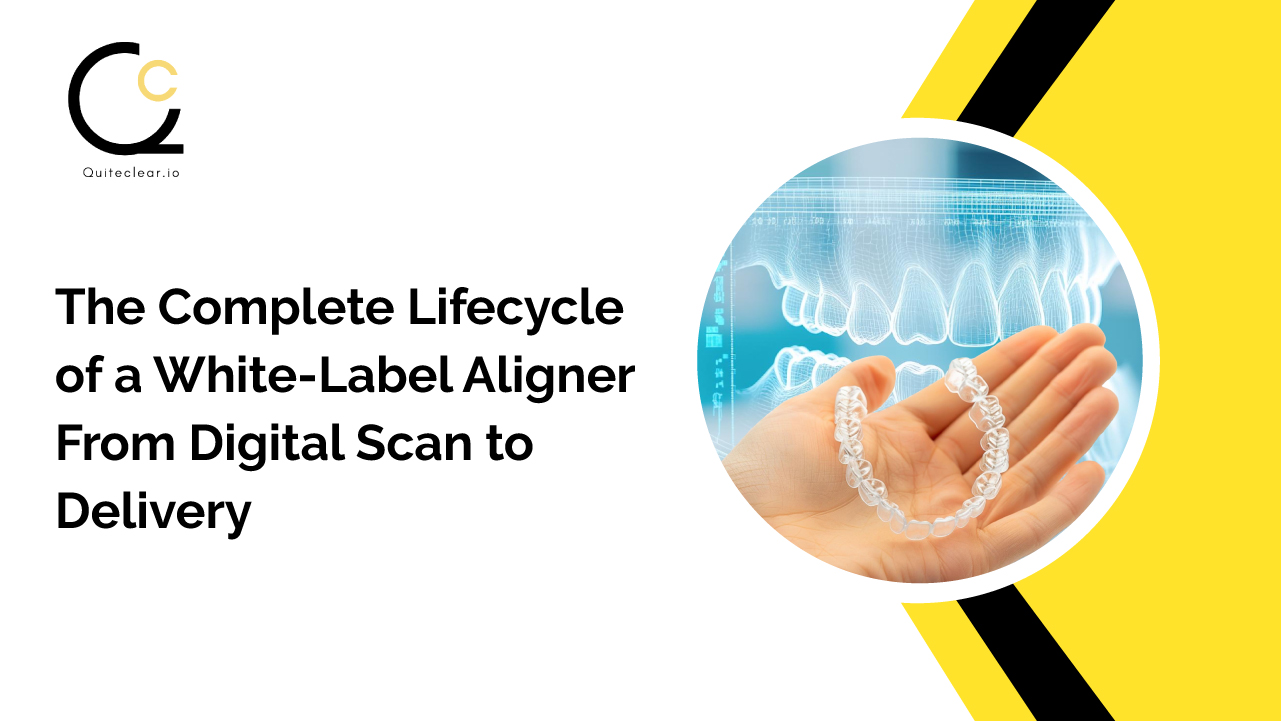The Complete Lifecycle of a White-Label Aligner: From Digital Scan to Delivery

When a patient slips on their first clear aligner, they’re stepping into a carefully choreographed process one that began long before the package arrived at your clinic or their doorstep. But what goes on behind the scenes? From a quick digital scan at the dental chair to a series of custom-fit aligners arriving in sleek, branded packaging, every step in the lifecycle of a white-label aligner is powered by precision, tech, and teamwork.
In this blog, we’ll take you inside the full journey, revealing how modern aligner brands are built, one batch at a time. Whether you’re a clinic considering offering white-label solutions or a brand looking to scale, this behind-the-scenes breakdown will show you how it all comes together seamlessly.
Step 1: Digital Scan and Initial Assessment: Every white-label aligner journey starts with a digital scan. Intraoral scanners have replaced messy impressions with fast, accurate 3D images, improving both comfort and precision. A clean, distortion-free scan is critical for treatment success. It ensures that aligners fit well and move teeth as planned. That’s why this step is handled by trained staff or the dentist, depending on the clinic’s setup. Once captured, the scan is uploaded to the aligner partner’s portal, ready for the treatment planning phase.
Step 2: Treatment Planning and Case Submission: Once the scan is completed, it’s uploaded to the planning software. Here, orthodontists take over to design a custom treatment roadmap, step by step, tooth by tooth. Using advanced software, they simulate how the teeth will move across the aligner stages.
Step 3: Aligner Design and Manufacturing: Approved plans are translated into precise aligner stages using CAD (Computer-Aided Design) tools. Each stage reflects a controlled tooth movement, ensuring both comfort and clinical accuracy. The aligners are then produced using medical-grade, BPA-free thermoplastics. 3D printing and thermoforming techniques help create perfectly contoured aligners that are both strong and nearly invisible.
Step 4: Quality Control and Branding: Before shipping, every aligner set undergoes a series of quality checks, verifying the fit, material strength, and accuracy of each stage. For white-label partners, this is also where branding elements are added: custom packaging, logo stickers, patient instructions, and even extras like aligner cases, chewies, or whitening kits. It’s not just about function; it’s about delivering a premium, branded experience.
Step 5: Packaging and Final Delivery: Aligners are sorted and packaged, each stage carefully labeled, with brand logo and stage number. Depending on the agreement, the kits are then shipped either directly to the clinic or straight to the patient’s door. Efficient logistics and optimized turnaround times ensure minimal delays, so treatment can begin on schedule.
The Role of Tech and Automation Throughout the Lifecycle
Behind the scenes of every successful white-label aligner system is a robust digital backbone powered by AI and automation.
AI in treatment planning plays an important role in analyzing tooth movement, optimizing staging, and predicting outcomes with remarkable precision. It assists Orthodontist in designing faster, safer, and more predictable treatments, helping reduce human error while increasing customization.
In the manufacturing stage, automation ensures consistency at scale. From 3D printing aligner molds to automated trimming, polishing, and sorting, every step is optimized for speed without sacrificing quality. Even order tracking and fulfillment are tech-driven, letting clinics and patients follow the status of their aligners in real time.
These end-to-end digital workflows not only reduce manual intervention but also boost efficiency, scalability, and turnaround time. Whether you’re handling 10 cases or 10,000, technology keeps the entire lifecycle smooth, smart, and streamlined.
Why Choosing the Right White-Label Partner Matters?
Not all white-label aligner providers are built the same, and the partner you choose can make or break your brand’s success. From treatment accuracy to packaging quality, every detail reflects on your clinic or D2C brand. A reliable partner ensures that your aligners don’t just straighten teeth, they build trust, elevate your brand, and keep patients coming back (or referring others).
At Quite Clear, we don’t just deliver aligners; we deliver confidence.
- Our fast, automated manufacturing keeps turnaround times short
- Our custom white-label packaging puts your brand front and center
- And our dedicated support team works with you every step of the way
Whether you’re launching a new aligner brand or expanding your clinic’s offerings, Quiteclear gives you a ready-to-scale, quality-assured solution without the operational headache.
Because at the end of the day, it’s not just about the aligners. It’s about the experience you’re delivering. And with Quiteclear, that experience is seamless.
From a quick digital scan to a confident smile, the lifecycle of a white-label aligner is a blend of precision, technology, and collaboration. Each stage, scanning, planning, manufacturing, packaging, and delivery, plays a critical role in ensuring the treatment is effective, timely, and brand-worthy.
For clinics and D2C brands looking to grow without compromising quality, choosing the right white-label partner isn’t just important, it’s essential. At Quiteclear, we simplify the complex. Our tech-enabled, quality-first approach gives you more than just aligners; we give you a system that scales, a brand that shines, and patients who smile with confidence.
Ready to take your aligner brand to the next level? Let’s build it together.
